Introduction to Commercial Drones
Commercial drones, also known as unmanned aerial vehicles (UAVs), have revolutionized various industries by offering innovative solutions to traditional challenges. From agriculture to real estate, the applications of drones are vast and varied. This article delves into the opportunities presented by commercial drones and the regulatory framework governing their use.
Opportunities Presented by Commercial Drones
The use of commercial drones spans across multiple sectors, providing efficiency, cost reduction, and enhanced data collection capabilities. Below are some key areas where drones are making an impact:
- Agriculture: Drones are used for crop monitoring, spraying, and surveying, significantly reducing the time and labor required.
- Construction: They offer aerial views of construction sites, aiding in planning, monitoring, and inspection.
- Real Estate: Drones capture stunning aerial photographs and videos of properties, enhancing marketing efforts.
- Delivery Services: Companies are experimenting with drones for delivering packages, promising faster and more efficient service.
Regulatory Framework for Commercial Drones
As the use of commercial drones grows, so does the need for regulations to ensure safety and privacy. The Federal Aviation Administration (FAA) in the United States and similar bodies worldwide have established rules for drone operations. Key regulations include:
- Registration of drones above a certain weight.
- Restrictions on flying near airports and in controlled airspace.
- Requirements for operators to obtain a license or certification for commercial use.
- Privacy laws that protect individuals from unauthorized surveillance.
Challenges and Future Prospects
Despite their potential, commercial drones face challenges such as public skepticism, privacy concerns, and technical limitations. However, advancements in technology and evolving regulations are paving the way for broader adoption. The future of commercial drones looks promising, with innovations like autonomous flight and beyond-visual-line-of-sight (BVLOS) operations on the horizon.
Conclusion
Commercial drones offer tremendous opportunities across various industries, but their use is subject to a complex regulatory landscape. As technology advances and regulations evolve, the potential for drones to transform industries is limitless. Stakeholders must navigate these opportunities and challenges carefully to harness the full potential of commercial drones.
For more insights into the latest in drone technology, check out our technology section.
